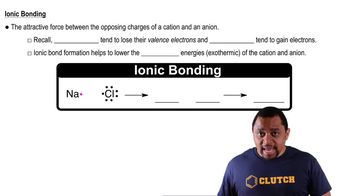Ch.22 - Chemistry of the Nonmetals

Brown15th EditionChemistry: The Central ScienceISBN: 9780137542970Not the one you use?Change textbook
Chapter 22, Problem 15
Complete the exercises below. Which of the following statements are true? a. Both nitrogen and phosphorus can form a pentafluoride compound. b. Although CO is a well-known compound, SiO does not exist under ordinary conditions. c. Cl₂ is easier to oxidize than I₂. d. At room temperature, the stable form of oxygen is O₂, whereas that of sulfur is S₈.
 Verified step by step guidance
Verified step by step guidance1
Step 1: Analyze statement (a). Consider the ability of nitrogen and phosphorus to form pentafluoride compounds. Nitrogen typically forms NF₃ due to its inability to expand its octet, while phosphorus can form PF₅ because it can expand its valence shell.
Step 2: Evaluate statement (b). Compare the bonding and stability of CO and SiO. Carbon monoxide (CO) is stable due to strong triple bonding, whereas silicon monoxide (SiO) is unstable under ordinary conditions because silicon prefers to form SiO₂.
Step 3: Assess statement (c). Consider the relative ease of oxidation of Cl₂ and I₂. Chlorine (Cl₂) is a stronger oxidizing agent than iodine (I₂), meaning Cl₂ is more likely to gain electrons and be reduced, not oxidized.
Step 4: Examine statement (d). Identify the stable forms of oxygen and sulfur at room temperature. Oxygen exists as O₂ due to its diatomic nature, while sulfur forms S₈, a ring structure, as its most stable allotrope.
Step 5: Review each statement based on the analysis above to determine which are true.
Key Concepts
Here are the essential concepts you must grasp in order to answer the question correctly.
Chemical Bonding and Compound Formation
Chemical bonding involves the interaction between atoms to form compounds. Elements like nitrogen and phosphorus can form various compounds, including pentafluorides, due to their ability to expand their valence shell and accommodate more than eight electrons. Understanding the bonding capabilities of elements is crucial for predicting the existence of certain compounds.
Recommended video:
Guided course

Chemical Bonds
Stability of Compounds
The stability of a compound often depends on its molecular structure and the conditions under which it exists. For example, carbon monoxide (CO) is stable under normal conditions, while silicon monoxide (SiO) is less stable and may not exist as a distinct compound at room temperature. Recognizing the factors that influence compound stability helps in understanding the behavior of different substances.
Recommended video:
Guided course

Intepreting the Band of Stability
Oxidizing Agents and Reactivity
Oxidizing agents are substances that can accept electrons in a chemical reaction, leading to oxidation of another species. The reactivity of halogens, such as chlorine (Cl₂) and iodine (I₂), varies, with Cl₂ being a stronger oxidizing agent than I₂. This concept is essential for predicting the outcomes of redox reactions and understanding the relative reactivity of different elements.
Recommended video:
Guided course

Oxidizing and Reducing Agents
Related Practice
